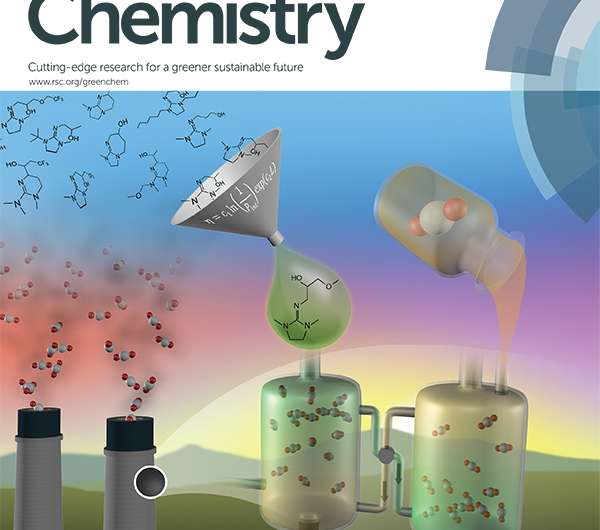Catching more carbon with less sticky solvents

For coal- and natural-gas-fired power plants, scientists want a liquid that captures carbon dioxide. But the water-lean solvents they prefer thicken to the consistency of cold honey the more carbon they catch. Finding better options is laborious and expensive. Each new solvent can take months to create and longer to test. Scientists at Pacific Northwest National Laboratory found a new way. They created and validated a computational model that predicts how easily a solvent will flow and how much carbon it will capture.
"We are figuring out how to connect the molecular-level information with bulk properties and do that in short time," said Dr. Vanda Glezakou, who led the study. "Ultimately, this translates to a fundamental understanding of a technology challenge and real cost savings in synthesis, because with our model each time you try, you are more likely to get a winner."
Capturing carbon dioxide could help improve our air quality and possibly provide a source of carbon for chemical and fuel production. The team's computational model can—in a few hours or days—show the properties of a potential solvent.
"We're hoping to drive down the capital and operation costs," said chemist Dr. Roger Rousseau, who worked on the study. "With a lower viscosity, we can run the process with smaller equipment sizes at lower temperatures. Both of these factors help drive down the impact using this technology would have on power generation."
The team took ideas, published earlier this year, and turned them into practical rules embedded in a computational model. "We often rely on chemical intuition to design materials, but intuition can only take you so far," said Dr. Phillip K. Koech who led materials design and synthesis team. His team synthesized the solvents used to test and validate the model. "With the power of simulation, we can evaluate material properties without having to make them."
The model offers definitive, accurate predictions about different carbon-capture solvents. "The biggest challenge in building the model was that there weren't any viscosity models for this type of solvent," said Cantu. "We had to find the molecular properties that really indicated viscosity. It wasn't obvious nor trivial."
The model uses a mathematical formula to describe the distribution of positive charges in two different parts of the solvent molecule. The distribution of positively charged protons is a key indicator of viscosity. These models connect a solvent's atomic structure to its macroscopic behavior.
The model lets scientists quickly screen solvents and opens the door for the atom-by-atom design of low viscosity, water-lean solvents. Using the information from the model, chemists can focus on the best candidates.
The team is using the model to screen a large library of materials to select materials that flow easily and pick up massive amounts of carbon dioxide, as well as meeting other criteria. "We are planning on taking the model and applying it to every other solvent chemistry that is out there and making it available to the scientific community," said Dr. David Heldebrant, who manages the project at PNNL. "Because we are a national laboratory, we want to address problems at the national level, such as providing cleaner power for the future."
The methodological approach used in this problem can be extended beyond solvents. " Our team is poised to help address other scientific and technology challenges in ways unique to PNNL's interdisciplinary teams, and we are looking forward to new challenges," said Glezakou.
More information: David C. Cantu et al. Structure–property reduced order model for viscosity prediction in single-component CO-binding organic liquids, Green Chem. (2016). DOI: 10.1039/c6gc02203k
Provided by Pacific Northwest National Laboratory




















